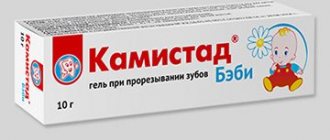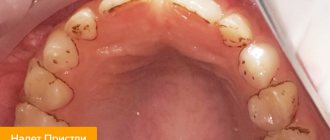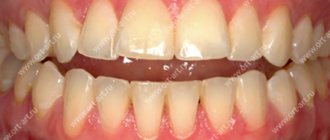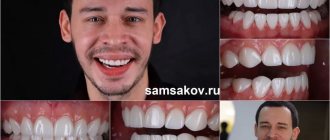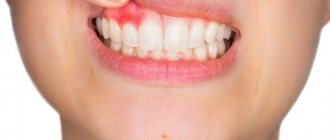Malocclusion or abnormal development of the jaw are far from the rarest cases in dental practice. Such disorders can be provoked by excessive pressure on the muscles of the cheeks, lips or tongue in childhood, and in order to minimize such phenomena, the Frenkel apparatus .
This orthopedic design received its name in honor of its creator, Doctor of Medical Sciences Rolf Frenkel, who successfully developed it (some sources claim that he improved an existing one) and introduced it into dental practice.
The corrector is a rather complex orthopedic structure, which is created in a dental laboratory using individual casts and impressions of small patients. As a result, the Frenkel apparatus fits correctly in the child’s mouth and creates favorable conditions for the formation of the desired bite and straight teeth. Moreover, with the help of the design it becomes possible to activate or inhibit jaw growth.
The corrector is used from 4 to 7 years of age, when children's milk teeth begin to change to permanent ones. And as the jaw grows, its shape and size are adjusted. The removable device is used mainly at night (during sleep) and for several hours during the day.
Production
The device is created by specialists in a dental laboratory. It is removable and can be installed on two jaws at once. The design includes the following elements:
- frame;
- cheek shields;
- lip pelota.
The frame is made of durable metal wire, which is formed into arcs. There are several of the latter in the product:
- palatal;
- lingual;
- vestibular;
- lingual (added in some cases).
Pilots and shields are special flaps to limit unnecessary force. They can be either metal or plastic. The width is determined by the degree of pathology, but does not exceed two and a half millimeters. All elements are polished to avoid injury to the periodontium and dentin.
The product is manufactured individually for each patient. The basis is taken from impressions and impressions of teeth made in advance.
Pros and cons of using removable orthodontic appliances
Correction of the bite in a child under the age of 13 is possible only with the use of appropriate corrective plates - braces can be installed only after the formation of a permanent dentition (more often this occurs before the appearance of the outer chewing teeth - wisdom teeth (the end of apexogenesis and mineralization of the enamel, this occurs after tooth eruption, after 3 years).
Wearing removable orthodontic devices to correct your malocclusion has many benefits, including:
- It is possible to make the base of the plates in different colors - this is especially true for young children, who will be more willing to wear a beautiful, bright design.
- High production speed - the maximum production time for a removable orthodontic appliance is one week.
- Reasonable price – the price for the simplest braces will be several times higher.
- Easy to maintain - the plate/device only needs to be cleaned twice a day with a brush and gel (morning and evening).
The disadvantages include a long period of use - to achieve a visible result, you need to be with the plate at least 12 hours a day (the more we wear by the hour, the less by month). On average, you need to wear the plate for at least one year. Adaptation to orthodontic removable appliances occurs more slowly than to braces. The child experiences discomfort while caring for the plate (at this time the plate/device must be removed).
Encourage your children to have a beautiful smile!
Kinds
There are several types of Frenkel function regulator, each of which has its own characteristics. The doctor selects the appropriate option depending on the nature of the existing pathology and its severity.
FR-1
There are three types:
- FR-la;
- FR-lb;
- FR-lc.
The basis of the design is the lingual and palatal arches, which are fastened with pelotas. The main indication is a distal bite with incisors inclined forward. During the correction process, the dentition expands to create free space. As a result, the front teeth are given the opportunity to grow properly.
FR-2
This device is used to correct distal occlusion, combined with an inclination of the upper incisors towards the palate.
Peculiarities:
- special shape of loops;
- double pilots.
Fr-3
The device differs significantly from other types in its design. There are special side pads. Lip patches are fixed only in the upper lip area. The third type of adjuster is prescribed to correct mesial occlusion caused by lower prognathism or excessive development of the lower jaw.
Fr-4
The vestibular arch is installed on the upper dentition, and the pelota on the lower lip. Indication for use: open bite. The device eliminates factors inhibiting the growth of the lower jaw. Metal overlays on the sides of the dentition allow you to separate the bite and achieve dentoalveolar shortening.
Duration of treatment
The duration of treatment for dental anomalies will directly depend on the complexity of the pathology. It is also worth considering the patient's age.
The main age category for which this device will be most effective is 4–11 years . The younger the child’s age, the faster the correction will take place.
from 4 to 8 months to correct mild anomalies .
For more complex pathologies, this period can stretch up to 1.5 years . In addition, it is necessary to take into account the individual developmental characteristics of each child and the degree of compliance with the daily wearing regime.
The peculiarity of the device is that it must be worn only at night, putting it on while sleeping. The therapeutic effect can be enhanced by using the device for an additional few hours during the day. While wearing the structure, you should not talk or chew.
As a rule, a positive result from treatment is visible within 2–4 months, depending on the complexity of the case.
Since the correction takes a very long period, during which the growth of the jaw does not stop, regular replacement of the apparatus is required during the treatment process . Typically, during 1.5 years of treatment, replacements are made no more than 3 times.
As a result of the correctly selected type of device, not only the aesthetics of a smile improves, but also breathing and speech are normalized, and bad myofunctional habits are eliminated.
How the process of installing and adjusting the device takes place, watch the video:
Wearing rules and care
Before starting therapy, the orthodontist gives detailed recommendations on the use and care of the regulator. The device should only be worn while sleeping because you should not chew or talk while wearing it. To enhance the effect, you can wear it for an additional three hours during the day. It does not cause discomfort to small patients (unlike many other orthodontic structures). Another advantage is the rapid adaptation period.
During the treatment process, you will need to change the product 2-3 times, because the child’s jaws are actively growing, and the effectiveness of the correction may decrease.
The device must be cleaned regularly to avoid the accumulation of bacteria on its surface. If you neglect proper care, this is fraught with the development of caries.
Operating principle
Unlike many other devices, correction of occlusion here is achieved by influencing the structural elements on individual muscles, processes of the alveolar ridges and areas of the dentition.
Due to this, the apical base, occlusal relationship, and movement of the tooth body are normalized.
The device allows you to eliminate excessive pressure on the lips and cheeks on problem areas, normalize the function of nasal breathing, proper closure of the lips, and form the desired position of the tongue .
Due to its wide capabilities, this device was called a function controller. The main importance in this design are shields and pads, which stimulate the expansion of the apical base in all directions and form the correct functioning of the muscles.
The main importance when using this device is the regulation of muscle tone. The design is made in such a way that it leads to relaxation of certain muscle groups in problem areas, as a result of which the correction is painless.
Elastic positioners have been developed for this device, which have a completely different appearance, but have the same functional effect as the Frenkel device.
Its difference lies in the possibility of combining elements to adapt to a specific problem, which significantly increases the effect of treatment .
Causes
The causes of open bite can be divided into prenatal and postnatal. The first group includes the following:
- various unfavorable hereditary factors;
- infectious and somatic diseases suffered by the woman;
- bad habits and unbalanced diet of a pregnant woman;
- severe toxicosis.
All these factors can influence the process of bite formation in primary and permanent teeth. In this case, more serious concomitant pathologies may develop, such as cleft lip, deformation of the entire jaw, etc. Therefore, when identifying any malocclusion, it is important to conduct a comprehensive examination.
An open bite may develop in the postnatal period due to internal or external factors. In the first case, we are talking about a lack of certain microelements in the body, as well as a violation of metabolic processes.
Another common cause of malocclusion is that the child has problems with nasal breathing. In this regard, he begins to systematically breathe through his mouth, getting used to keeping it open. If parents notice such features, they should check the structure of the nasopharynx, especially the nasal septum, as soon as possible and begin treatment. Otherwise, the child may develop not only an open bite, but also other jaw pathologies.
The group of external factors includes the following:
- the child’s habit of biting nails or other foreign objects, for example, toys, pen caps, etc.;
- thumb sucking during the eruption of baby teeth;
- frequent protruding of the tongue between the teeth with the mouth open.
Often in these cases, the very form of the malocclusion begins to resemble the outline of the object that the child held in the mouth - a finger, a toy, etc.
Pathogenesis of open bite
It should be remembered that an open bite can appear in the prenatal period. In this case, the incorrect position of the teeth begins in their rudiments. Therefore, they initially begin to grow crookedly.
Since the rudiments of molars are formed simultaneously with milk teeth, they can also have pathology. This is why in such cases it will not be enough to correct an open bite at an early age. In most cases, therapy will have to be repeated when permanent teeth erupt.
If the bite pathology is caused by external factors, then the formation process is somewhat different. In this case, the position of the dentition is initially correct, but over time it becomes deformed. It is important to notice such distortions in time and begin to correct them. Typically, the latter type of malocclusion is more amenable to treatment compared to congenital pathology.
What is an open bite?
An open bite is a malposition of the dentition in which the front or lateral teeth of the upper and lower jaws do not meet. In this case, not only physiological disorders are observed, but also functional ones. Due to the lack of bite contact, a person cannot chew food well, as a result of which it enters other organs of the gastrointestinal tract in this form. This is why people with open bites often suffer from digestive problems.
This malocclusion can occur in both children and adults. In the absence of adequate treatment, its severity may worsen, and over the years it will become more and more difficult to correct it.
Diagnosis of open bite
Often, diagnosing an open bite does not require much time. Usually, the doctor can point out this pathology during the first examination of the patient. To confirm the diagnosis, he can schedule an additional visit to the orthodontist, who can more competently determine the causes of malocclusion and prescribe comprehensive treatment.
If malocclusion was identified at an early age, the doctor may recommend taking an X-ray of the jaw. It is needed to determine the condition of permanent teeth that have not yet appeared on the surface.
